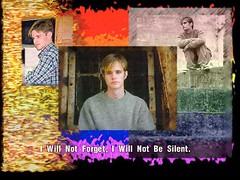October 12th 2005, is the seventh anniversary of my son Matthew's murder. His murder prompted unprecedented media coverage and focused the nation's attention on anti-gay hate crimes like never before. These past few weeks I have been thinking about what has changed - and what has not changed. What has been done to make our communities safe from violence resulting from anti-gay hate? I quickly learned my son's violent death was a fairly common occurrence. This prompted our family to create the Matthew Shepard Foundation and do our part to create a more respectful and caring culture free from hate. I have spent the past seven years traveling across the nation, speaking to schools, churches, anyone who will listen, to try and stem the tide of hate that is eating away at the fabric of our culture.
The number of hate crimes against gay, lesbian, bisexual and transgender people has not varied much during the last five years. They remain the third highest category after race and religion. However, it is apparent that there are certain changes in the 'environment' that do impact hate crime activity. In New York City, every July, anti-gay violence usually increases by about 8% as people respond to the outreach programs and the visibility of the Pride celebrations. After the Lawrence v. Texas decision and the premiere of additional gay identified television shows, anti-gay violence in New York City rose 52%.
It's clear that in some ways, our nation has become a more accepting place. We have witnessed the progress of gay and lesbian rights with the recent Supreme Court decision, Lawrence v Texas. We have seen our neighbor to the North - Ontario, Canada - acknowledge same-sex marriages. They have recognized that same sex couples are as deserving of the same equal rights and responsibilities as heterosexual couples. We have seen gay adoptions increase. We have seen growing visibility, acceptance and understanding of lesbian, gay, bisexual and transgender people in our families, in the corporate world and in our culture.
However, we must also remember that there has been scant progress in areas of legislation and securing equal rights for the gay community. We continue to fight for hate crime legislation that will include sexual orientation, gender, and disability, and for federal job protection based on sexual orientation. Yes, you can be fired for being gay, lesbian, bisexual or transgender in 36 states of this nation. It is as if we are living in two Americas - one that tunes in to "Queer Eye for a Straight Guy" but turns a blind eye to the injustices gay and lesbian people still face.
It is evident that with progress comes the inevitable attack by those who are threatened by our work for justice and fairness. Visibility - whether in the media or being out of the closet if you are gay - can serve as an unfortunate catalyst. Those who are threatened by our community are threatened by these strides. In 2003, more than 30 cities and towns reported crimes against gays. The vast majority do not garner national headlines like my son's murder did. Sakia Gunn, a 15 year old lesbian was fatally stabbed in Newark, New Jersey on 5/11/03, F.C. Martinez, a Navajo, transgender 16-year old murdered in a bias motivated attack are two examples but the list goes on. We have so far to go, so much hate is out there. It must be acknowledged, addressed and erased before any of us are safe.
As we approach the anniversary of Matthew's murder it is appropriate to redouble my efforts to invoke a grassroots solution to this problem. It is a solution that begins with parents, educators, clergy and our communities as a whole. We have the opportunity to help our children understand and accept diversity before their school years begin and before hate can provoke violent actions. If we do our jobs correctly, it should never cross the minds of our children to harm someone, physically or emotionally, because of their gender, race, national origin, religion, disability or gender identity and expression.
Hate is a learned behavior. If a child is taught to hate and fear diversity, then the next place he or she expresses that hate is at school. Ten percent of all hate crimes occur at schools and colleges . Bullying in our nation's schools has resulted in countless acts of violence. The cycle continues until that child who is filled with hate becomes an adult citizen in your community and begins to teach others to hate.
Please help your children understand diversity without fearing it. Be an example of acceptance and compassion. The consequences of hate hurt everyone. It hurts not only the victim - it hurts their family and friends. It destroys the families of the perpetrators. Lives are lost, lives are ruined and lives are changed forever.
Matthew Shepard Foundation
skip to main |
skip to sidebar

